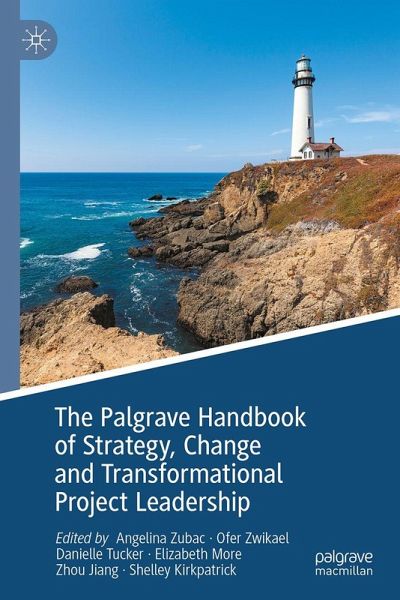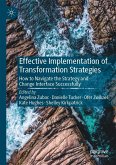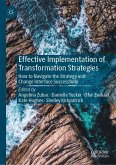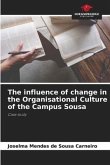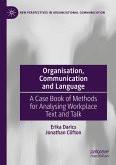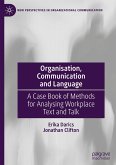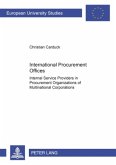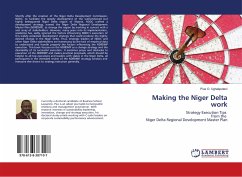The Palgrave Handbook of Strategy, Change and Transformational Project Leadership
Herausgegeben:Zubac, Angelina; Zwikael, Ofer; Tucker, Danielle; More, Elizabeth; Jiang, Zhou; Kirkpatrick, Shelley
Versandkostenfrei innerhalb Deutschlands
151,99 €
inkl. MwSt.
Versandkostenfrei*
Erscheint vorauss. 10. Juni 2026
Melden Sie sich
hier
hier
für den Produktalarm an, um über die Verfügbarkeit des Produkts informiert zu werden.

76 °P sammeln
The Palgrave Handbook of Strategy, Change and Transformational Project Leadership
Herausgegeben:Zubac, Angelina; Zwikael, Ofer; Tucker, Danielle; More, Elizabeth; Jiang, Zhou; Kirkpatrick, Shelley
- Gebundenes Buch
This handbook presents contemporary research on the topic of strategy, change and transformational project leadership to identify new ways of thinking about management problems, research and pedagogy. The frameworks it develops answers the call from business leaders to be provided with more powerful tools, based on empirically derived theories, for making better strategic decisions, given how interconnected and reliant on digital technologies, complex and uncertain the world has become.
Andere Kunden interessierten sich auch für
![Effective Implementation of Transformation Strategies Effective Implementation of Transformation Strategies]() Effective Implementation of Transformation Strategies34,99 €
Effective Implementation of Transformation Strategies34,99 €![Effective Implementation of Transformation Strategies Effective Implementation of Transformation Strategies]() Effective Implementation of Transformation Strategies34,99 €
Effective Implementation of Transformation Strategies34,99 €![The influence of change in the Organisational Culture of the Campus Sousa The influence of change in the Organisational Culture of the Campus Sousa]() Joselma Mendes de Sousa CarneiroThe influence of change in the Organisational Culture of the Campus Sousa36,99 €
Joselma Mendes de Sousa CarneiroThe influence of change in the Organisational Culture of the Campus Sousa36,99 €![Organisation, Communication and Language Organisation, Communication and Language]() Erika DaricsOrganisation, Communication and Language113,99 €
Erika DaricsOrganisation, Communication and Language113,99 €![Organisation, Communication and Language Organisation, Communication and Language]() Erika DaricsOrganisation, Communication and Language113,99 €
Erika DaricsOrganisation, Communication and Language113,99 €![International Procurement Offices International Procurement Offices]() Christian CarduckInternational Procurement Offices105,65 €
Christian CarduckInternational Procurement Offices105,65 €![Making the Niger Delta work Making the Niger Delta work]() Pius O. UghakpoteniMaking the Niger Delta work17,99 €
Pius O. UghakpoteniMaking the Niger Delta work17,99 €-
-
-
This handbook presents contemporary research on the topic of strategy, change and transformational project leadership to identify new ways of thinking about management problems, research and pedagogy. The frameworks it develops answers the call from business leaders to be provided with more powerful tools, based on empirically derived theories, for making better strategic decisions, given how interconnected and reliant on digital technologies, complex and uncertain the world has become.
Produktdetails
- Produktdetails
- Verlag: Springer, Berlin; Palgrave Macmillan
- Artikelnr. des Verlages: 89275436
- Erscheinungstermin: 10. Juni 2026
- Englisch
- ISBN-13: 9789819535873
- ISBN-10: 9819535875
- Artikelnr.: 75409291
- Herstellerkennzeichnung
- Springer-Verlag GmbH
- Tiergartenstr. 17
- 69121 Heidelberg
- ProductSafety@springernature.com
- Verlag: Springer, Berlin; Palgrave Macmillan
- Artikelnr. des Verlages: 89275436
- Erscheinungstermin: 10. Juni 2026
- Englisch
- ISBN-13: 9789819535873
- ISBN-10: 9819535875
- Artikelnr.: 75409291
- Herstellerkennzeichnung
- Springer-Verlag GmbH
- Tiergartenstr. 17
- 69121 Heidelberg
- ProductSafety@springernature.com
Dr Angelina Zubac has published many scholarly and professional articles and book chapters, levering off a 35-year career where she worked as a strategy consultant, manager, board member and academic at over 100 Australian organisations. Professor Ofer Zwikael has authored six books and over 300 articles, earning multiple research awards and recognition on Stanford University’s list of the world’s top 2% of scientists for his pioneering work on project benefits management. He also serves as an Associate Editor of the International Journal of Project Management. Dr Danielle Tucker has published many organisational and culture change articles, including in such journals as Human Relations and Journal of Business Ethics. She recently published a book on contemporary practice: Organizational Change Management: Inclusion, Collaboration and Digital Change in Practice. Professor Zhou (Joe) Jiang is a Department Head and experienced journal editor. He has published over 70 articles in leading management journals and has received many awards for his research in supporting sustainable managerial practices and career well-being. He is named in Stanford University’s World Top 2% Scientists list. Emeritus Professor Elizabeth More has published numerous chapters and articles, such as in the Journal of Leadership in Health Services and Journal of Communication Management. She is a respected editor, board member and TEQSA Commissioner. Dr Shelley Kirkpatrick has published over 50 scholarly and practitioner-focused articles on leadership and motivation. She co-authored The Government Leader’s Field Guide to Organizational Agility. Her first book Build a Better Vision Statement: Extending Research with Practical Advice helped many leaders develop winning vision statements.
.- Section 1: Book Introduction.
.- 1. Introduction: Strategy, change and transformational project
leadership.
.- Section 2: The Strategy Process, Sustainability and People.
.- 2. Introduction: The strategy process, sustainability and people.
.- 3. The beauty of strategic change initiatives: A story about
psychological pain and pleasure on the path to greatness.
.- 4. How can project management help the organisation constructively
advance its strategic change agenda?.
.- 5. Strategic change as wayfinding.
.- 6. Sustainability and complexity in strategic management: A new
methodological perspective and its application in the EU auto industry.
.- 7. The portfolio hierarchy and the strategically agile organization.
.- Section 3: The Financial Strategy, Sustainability and People.
.- 8. Introduction: The financial strategy, sustainability and people.
.- 9. Towards a sustainable future: Participating in and benefiting from
the circular economy.
.- 10. Strategic management accounting at the environmentally responsible
organization.
.- 11. Organisations’ human, resource and risk tolerance architectures:
Realising them through the financial strategy.
.- Section 4: The Customer Value Creation Strategy, Sustainability and
People.
.- 12. Introduction: The customer value creation strategy, sustainability
and people.
.- 13. Sustainable business models.
.- 14. Customer value creation at organisations where customers’ customers
are customers and their stakeholders are customers too.
.- 15. Value creation value capture revisited: Resource, entrepreneurial
and relational orientations.
.- Section 5: The Resource Strategy, Sustainability and People.
.- 16. Introduction: The resource strategy, sustainability and people.
.- 17. Culture is everything: What are we really trying to do when we
transform an organisation?.
.- 18. Agile processes and the use of discretion as it is needed: Getting
the balance right.
.- 19. Strategic decisions and fundamental skills: The car of the future
analogy, AI and the next generations of learning management systems.
.- 20. Cumulative theory development over 10 years of organisational change
case studies: What really matters?.
.- 21. Strategic talent management.
.- 22. Transforming the business portfolio: The Interactions and systems
that are necessary at large project-based organisations.
.- Section 6: Non-Market Strategies, Sustainability and People.
.- 23. Introduction: Non-market strategies, sustainability and people.
.- 24. The conundrum of a sustainable prosperous future.
.- 25. Agility and the public sector.
.- 26. Augmenting employee talents through focused volunteer
attraction-retention strategies: An Australian disability services case
study.
.- 27. When every second counts: Implementing disaster relief
strategically.
.- 28. Structuring stakeholder engagement for improving project,
operational and strategic effectiveness: A public sector case.
.- 1. Introduction: Strategy, change and transformational project
leadership.
.- Section 2: The Strategy Process, Sustainability and People.
.- 2. Introduction: The strategy process, sustainability and people.
.- 3. The beauty of strategic change initiatives: A story about
psychological pain and pleasure on the path to greatness.
.- 4. How can project management help the organisation constructively
advance its strategic change agenda?.
.- 5. Strategic change as wayfinding.
.- 6. Sustainability and complexity in strategic management: A new
methodological perspective and its application in the EU auto industry.
.- 7. The portfolio hierarchy and the strategically agile organization.
.- Section 3: The Financial Strategy, Sustainability and People.
.- 8. Introduction: The financial strategy, sustainability and people.
.- 9. Towards a sustainable future: Participating in and benefiting from
the circular economy.
.- 10. Strategic management accounting at the environmentally responsible
organization.
.- 11. Organisations’ human, resource and risk tolerance architectures:
Realising them through the financial strategy.
.- Section 4: The Customer Value Creation Strategy, Sustainability and
People.
.- 12. Introduction: The customer value creation strategy, sustainability
and people.
.- 13. Sustainable business models.
.- 14. Customer value creation at organisations where customers’ customers
are customers and their stakeholders are customers too.
.- 15. Value creation value capture revisited: Resource, entrepreneurial
and relational orientations.
.- Section 5: The Resource Strategy, Sustainability and People.
.- 16. Introduction: The resource strategy, sustainability and people.
.- 17. Culture is everything: What are we really trying to do when we
transform an organisation?.
.- 18. Agile processes and the use of discretion as it is needed: Getting
the balance right.
.- 19. Strategic decisions and fundamental skills: The car of the future
analogy, AI and the next generations of learning management systems.
.- 20. Cumulative theory development over 10 years of organisational change
case studies: What really matters?.
.- 21. Strategic talent management.
.- 22. Transforming the business portfolio: The Interactions and systems
that are necessary at large project-based organisations.
.- Section 6: Non-Market Strategies, Sustainability and People.
.- 23. Introduction: Non-market strategies, sustainability and people.
.- 24. The conundrum of a sustainable prosperous future.
.- 25. Agility and the public sector.
.- 26. Augmenting employee talents through focused volunteer
attraction-retention strategies: An Australian disability services case
study.
.- 27. When every second counts: Implementing disaster relief
strategically.
.- 28. Structuring stakeholder engagement for improving project,
operational and strategic effectiveness: A public sector case.
.- Section 1: Book Introduction.
.- 1. Introduction: Strategy, change and transformational project
leadership.
.- Section 2: The Strategy Process, Sustainability and People.
.- 2. Introduction: The strategy process, sustainability and people.
.- 3. The beauty of strategic change initiatives: A story about
psychological pain and pleasure on the path to greatness.
.- 4. How can project management help the organisation constructively
advance its strategic change agenda?.
.- 5. Strategic change as wayfinding.
.- 6. Sustainability and complexity in strategic management: A new
methodological perspective and its application in the EU auto industry.
.- 7. The portfolio hierarchy and the strategically agile organization.
.- Section 3: The Financial Strategy, Sustainability and People.
.- 8. Introduction: The financial strategy, sustainability and people.
.- 9. Towards a sustainable future: Participating in and benefiting from
the circular economy.
.- 10. Strategic management accounting at the environmentally responsible
organization.
.- 11. Organisations’ human, resource and risk tolerance architectures:
Realising them through the financial strategy.
.- Section 4: The Customer Value Creation Strategy, Sustainability and
People.
.- 12. Introduction: The customer value creation strategy, sustainability
and people.
.- 13. Sustainable business models.
.- 14. Customer value creation at organisations where customers’ customers
are customers and their stakeholders are customers too.
.- 15. Value creation value capture revisited: Resource, entrepreneurial
and relational orientations.
.- Section 5: The Resource Strategy, Sustainability and People.
.- 16. Introduction: The resource strategy, sustainability and people.
.- 17. Culture is everything: What are we really trying to do when we
transform an organisation?.
.- 18. Agile processes and the use of discretion as it is needed: Getting
the balance right.
.- 19. Strategic decisions and fundamental skills: The car of the future
analogy, AI and the next generations of learning management systems.
.- 20. Cumulative theory development over 10 years of organisational change
case studies: What really matters?.
.- 21. Strategic talent management.
.- 22. Transforming the business portfolio: The Interactions and systems
that are necessary at large project-based organisations.
.- Section 6: Non-Market Strategies, Sustainability and People.
.- 23. Introduction: Non-market strategies, sustainability and people.
.- 24. The conundrum of a sustainable prosperous future.
.- 25. Agility and the public sector.
.- 26. Augmenting employee talents through focused volunteer
attraction-retention strategies: An Australian disability services case
study.
.- 27. When every second counts: Implementing disaster relief
strategically.
.- 28. Structuring stakeholder engagement for improving project,
operational and strategic effectiveness: A public sector case.
.- 1. Introduction: Strategy, change and transformational project
leadership.
.- Section 2: The Strategy Process, Sustainability and People.
.- 2. Introduction: The strategy process, sustainability and people.
.- 3. The beauty of strategic change initiatives: A story about
psychological pain and pleasure on the path to greatness.
.- 4. How can project management help the organisation constructively
advance its strategic change agenda?.
.- 5. Strategic change as wayfinding.
.- 6. Sustainability and complexity in strategic management: A new
methodological perspective and its application in the EU auto industry.
.- 7. The portfolio hierarchy and the strategically agile organization.
.- Section 3: The Financial Strategy, Sustainability and People.
.- 8. Introduction: The financial strategy, sustainability and people.
.- 9. Towards a sustainable future: Participating in and benefiting from
the circular economy.
.- 10. Strategic management accounting at the environmentally responsible
organization.
.- 11. Organisations’ human, resource and risk tolerance architectures:
Realising them through the financial strategy.
.- Section 4: The Customer Value Creation Strategy, Sustainability and
People.
.- 12. Introduction: The customer value creation strategy, sustainability
and people.
.- 13. Sustainable business models.
.- 14. Customer value creation at organisations where customers’ customers
are customers and their stakeholders are customers too.
.- 15. Value creation value capture revisited: Resource, entrepreneurial
and relational orientations.
.- Section 5: The Resource Strategy, Sustainability and People.
.- 16. Introduction: The resource strategy, sustainability and people.
.- 17. Culture is everything: What are we really trying to do when we
transform an organisation?.
.- 18. Agile processes and the use of discretion as it is needed: Getting
the balance right.
.- 19. Strategic decisions and fundamental skills: The car of the future
analogy, AI and the next generations of learning management systems.
.- 20. Cumulative theory development over 10 years of organisational change
case studies: What really matters?.
.- 21. Strategic talent management.
.- 22. Transforming the business portfolio: The Interactions and systems
that are necessary at large project-based organisations.
.- Section 6: Non-Market Strategies, Sustainability and People.
.- 23. Introduction: Non-market strategies, sustainability and people.
.- 24. The conundrum of a sustainable prosperous future.
.- 25. Agility and the public sector.
.- 26. Augmenting employee talents through focused volunteer
attraction-retention strategies: An Australian disability services case
study.
.- 27. When every second counts: Implementing disaster relief
strategically.
.- 28. Structuring stakeholder engagement for improving project,
operational and strategic effectiveness: A public sector case.
